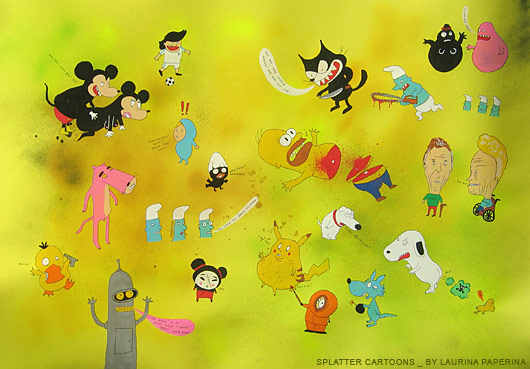Since
Silvia Evangelisti was appointed director last year, the Bologna Art Fair has
greatly improved. Bigger spaces, a clearer spread of the exhibitors, a satellite
pavilion for young galleries, and especially a new open-mindedness about
collateral events within the city made this year’s Arte Fiera a fresher and
definitely most enjoyable event.
Also,
the fact that many galleries in the past lost their interest in participating to
the oldest fair in Italy – it is now on its 30th year – made it possible for
younger and unusual galleries to show their hidden talents in the most visited
fair of the country.

All
that said, walking through the pavilions the first thing that spreads to mind is
that it’s just another fair. After a few dizzy minutes, the eye has to adjust to
the overwhelming lighting, and the quantity of artworks that assails you from
every corner can be ignored to enter a bubble of calmness and self-consciousness
that makes you forget this is just pure business and actually lets you enjoy the
experience of the art object.
Laurina
Paperina is a young artist from Trento who I’ve been following for quite some
time. Her hilarious drawings portraying superheroes are simple and fresh, yet
reveal all the cynicism and irony that is best known in Italian political
satirists. I was glad to see that her gallery, Perugi, finally gave her the
amount of visibility she deserves.
The
colorful sculptures of Sun Rae Kim, present in both Galleria Blu and Galerie
Robert Drees booths, were a nice novelty to me. The process is simple, you take
a doll (I presume) and make a rubber cast of it, then cover it with delicate
colorful paper leaves, making what resembles a child of the future’s cocoon,
something between a potpourri second skin and the lost aura of a forgotten
manga.
Another
interesting booth was the one of Base from Tokyo. The weird, erased paintings of
Ji Danchun were a pleasure to my eyes, so close to the contradictions of
contemporary society, they make you smile with lightness – perfect for heavy
times. Miwako Iga presented a series of mini plastic bras to comment about their
uncomfortability, funnily titled We always talk of our own ache, while
Akiko Tsuda reworks Renascence poses through decorative resin
mannequins.
Arndt
& Partner presented a solo exhibition of Nedko Solakov, an artist I didn’t
know, yet I can really relate with. His fucked up conceptual watercolors
show a distinct intellect, attentive to what is going on in the world, yes
disillusioned to the possible solutions. Psychologically speaking, it’s great to
let it all go through watercolors and irony.
French
galleries participated en masse to this fair, which is something quite
unusual. This gave the provincial punters of Bologna the opportunity to admire
some fabulous work of Anette Messager, some weird shoe sculptures by Madeleine
Berkhemer, and a wonderful installation by Pascale Marthine Tayou. An eclectic
artist, he filled the space with freakish colorful abstract drawings, neatly
framed, and a massive log of wood turned upside down. Titled She & He,
it featured two long piles of broken slides, badly glued together, but with
two neat cds underneath to act like coasters. A beautiful metaphor of the
contradictions of the modern couple.
As
far as Italian galleries are concerned, not much novelty was displayed. As usual
Massimo Minini and S.A.L.E.S. had the strongest Italian work on view, but I was
also pleasantly surprised by the quality of upcoming Amste. A young gallery from
Lissone, it featured Cesare Biratoni, Marjan Laaper, Jennifer Nuss, Adriano
Persiani and Tomas Vu Daniel, and all of them are worth the mention. Definitely
a gallery to keep an eye on.
For
the rest, I was interested in seeing a definite improvement in the quality of
many “photoshop works”, namely a wonderful Flemish-like “painting” by Emily
Allchurch, presented by Galica, an obsessively repeated portrait of a young girl
by Claudia Rogge at Galerie Voss, and some amazing areal views by Hiroyuki
Masuyama at Studio La Città that made you re-live your last flight in one,
single, very long photograph.
Sculpture
was big this year, and I found some very interesting pieces that – if I were a
collector – I would definitely think about taking home. A Grizzly Little
Fucker by David Mach, funny Chewing gum boys by Tommi Toija, a
strange metal cityscape by Baltazar Torres, some awesome fabric heads by Louise
Bourgeois, excellent flying rubbish by David Lindberg, and a saddening,
beautiful radio-video-robot piece by Nam June Paik, who died while the fair was
up. Let’s hope the great video master career will be celebrated with the major
retrospective he deserves.
The
best experience of this art fair was, for me, the possibility of admiring
L’esprit Nouveau from the inside. It’s a little satellite pavilion that
Le Corbusier designed in 1925 as an art space, featuring a housing module
replicable on two floors and a circular-shape annex. It was built in 1977 and it
is regarded as a manifesto of modern architecture and Functionalism. All my life
I found the building closed to the
public, and when I finally entered I was not disappointed. Although slightly
crammed with artworks from emerging galleries, the space revealed itself with
the purpose of what it was designed for: a living/working space for an artist.
The easiness of the feeling of the space inside it is rather hard to describe,
but it was indeed a highly enjoyable experience and, as an artist, it made me
really feel at home. It’s a shame modules like that are not available to artists
for real.